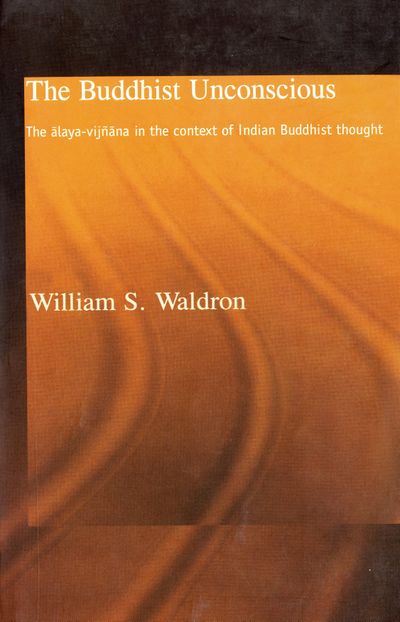(Created page with "{{Book |BookPerson={{Book-person |PersonPage=Waldron, W. |PersonName=William S. Waldron }} |FullTextRead=No |AddRelatedTab=No }}") |
No edit summary |
||
| Line 5: | Line 5: | ||
}} | }} | ||
|FullTextRead=No | |FullTextRead=No | ||
|BookToc=Preface xi | |||
Acknowledgments xv | |||
Thematic introduction: a Buddhist critique of | |||
the construction of self and world 1 | |||
PART I | |||
The background and context of the alaya-vijñana 7 | |||
1 The early Buddhist background 9 | |||
The three marks of existence 9 | |||
The formula of dependent arising 11 | |||
Causation and continuity without a self 16 | |||
Viññafa in the formula of dependent arising 19 | |||
Viññafa as consciousness 21 | |||
Viññafa as cognitive awareness 28 | |||
The underlying tendencies (anusaya) 33 | |||
The underlying tendency “I am” and conceptual | |||
proliferation (papañca) 36 | |||
The debate over latent versus manifest 39 | |||
Reciprocal causality between the two aspects of viññafa 41 | |||
2 The Abhidharma context 46 | |||
The Abhidharma project and its problematic 46 | |||
Background of the Abhidharma 47 | |||
The aim and methods of Abhidharma: dharma as | |||
irreducible unit of experience 50 | |||
The basic problematic: two levels of discourse, | |||
two dimensions of mind 55 | |||
Analysis of mind and its mental factors 57 | |||
The initial formulation of the problematic in its | |||
synchronic dimension: the accumulation of karmic | |||
potential, the presence of the underlying tendencies, | |||
and their gradual purification in the Kathavatthu 59 | |||
The problematic in its diachronic dimension: | |||
immediate succession versus the continuity | |||
of karmic potential 62 | |||
The persistence of traditional continuities: karma | |||
and kleka in the Abhidharma-koka 67 | |||
Abhidharmic responses to the problematic 70 | |||
The Sarvastivadin theory of possession (prapti) 72 | |||
The Sautrantika theory of seeds (bnja) in the | |||
mental stream (santana) 73 | |||
Questions raised by consciousness, seeds, and the | |||
mental stream 76 | |||
The Theravadin theory of life-constituent mind | |||
(bhavamga-citta) 81 | |||
Conclusion 85 | |||
PART II | |||
The alaya-vijñana in the Yogacara tradition 89 | |||
3 The alaya-vijñana in the early tradition 91 | |||
The origins of the alaya-vijñana 91 | |||
The new model of mind in the Saddhinirmocana Sjtra 94 | |||
The alaya-vijñana as mental stream 99 | |||
The Alaya Treatise of the Yogacarabhjmi 101 | |||
The Proof Portion 102 | |||
The Alaya Treatise, Pravgtti Portion: analyzing the | |||
alaya-vijñana in Abhidharmic terms 107 | |||
The alaya-vijñana’s subliminal objective supports | |||
and cognitive processes 109 | |||
The alaya-vijñana’s mutual and simultaneous relationship | |||
with manifest cognitive awareness (pravgtti-vijñana) 112 | |||
The alaya-vijñana’s simultaneous arising with | |||
(afflictive) mentation 117 | |||
The Alaya Treatise, Nivgtti Portion: equating the | |||
alaya-vijñana with samsaric continuity 123 | |||
Conclusion 127 | |||
4 The alaya-vijñana in the Mahayana-sadgraha | |||
1. bringing it all back home 128 | |||
Appropriating the traditional Buddhist framework 129 | |||
Synonyms of the alaya-vijñana in the disciple’s vehicle 130 | |||
The two vijñanas and the two dependent arisings 131 | |||
Seeding the alaya-vijñana: the karmic process as | |||
simultaneous intrapsychic causality 135 | |||
Resolving the Abhidharmic Problematic 139 | |||
Karma, rebirth, and the alaya-vijñana 140 | |||
The continuity of the afflictions (kleka) 142 | |||
The path of purification: mundane and supramundane 150 | |||
Beyond Abhidharma: adventitious defilements, pure seeds, | |||
and luminous minds 153 | |||
5 The alaya-vijñana in the Mahayana-sadgraha | |||
2. looking beyond 158 | |||
The predispositions of speech, self-view, and the | |||
life-constituents 159 | |||
Common experience, common embodiment: language, | |||
the alaya-vijñana, and “the arising of the world” 160 | |||
PART III | |||
Appendices 171 | |||
Appendix I The series of dependent arising: affliction, | |||
action, and their results 173 | |||
Appendix II Index of related controversies 175 | |||
Appendix III Translation: the Pravgtti and Nivgtti Portions of | |||
the Vinikcayasadgrahafn of the Yogacarabhjmi 178 | |||
Notes 190 | |||
Bibliography of works cited 247 | |||
Index of texts quoted 255 | |||
Index 259 | |||
|AddRelatedTab=No | |AddRelatedTab=No | ||
}} | }} | ||
Revision as of 15:10, 2 June 2020
This is the story of fifth century CE India, when the Yogacarin Buddhists tested the awareness of unawareness, and became aware of human unawareness to an extraordinary degree. They not only explicitly differentiated this dimension of mental processes from conscious cognitive processes, but also offered reasoned arguments on behalf of this dimension of mind. This is the concept of the 'Buddhist unconscious', which arose just as philosophical discourse in other circles was fiercely debating the limits of conscious awareness, and these ideas in turn had developed as a systematisation of teachings from the Buddha himself. For us in the twenty-first century, these teachings connect in fascinating ways to the Western conceptions of the 'cognitive unconscious' which have been elaborated in the work of Jung and Freud.
This important study reveals how the Buddhist unconscious illuminates and draws out aspects of current western thinking on the unconscious mind. One of the most intriguing connections is the idea that there is in fact no substantial 'self' underlying all mental activity; 'the thoughts themselves are the thinker'. William S. Waldron considers the implications of this radical notion, which, despite only recently gaining plausibility, was in fact first posited 2,500 years ago. (Source: Routledge)
| Citation | Waldron, William S. The Buddhist Unconscious: The Ālaya-Vijñāna in the Context of Indian Buddhist Thought. Routledge Critical Studies in Buddhism. London: RoutledgeCurzon, 2003. http://abhidharma.ru/A/Raznoe/0061.pdf. |
|---|---|

